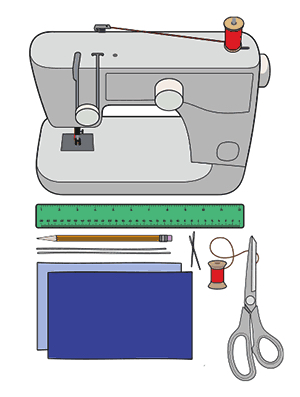- Protect Yourself and Save Others
- info@wearamask.org



Pick a good fabric and then get creative and have fun. The key is to make a mask that you will want to wear. Everyone has their own style and a face mask is 2020's hottest fashion accessory.
For a printable tutorial on how to sew a face mask from the New York Times, CLICK HERE
Any face covering is better than no face covering but research is showing that 100% cotton fabrics performed better than synthetic or blends. Also, you can experiment with homemade masks using coffee filters, air
filters and vacuum bags, but the average person doesn't need that level of protection and some filters have nano particles that should not be enhaled. So choose your filter carefully and it is usually recommended that a
cloth barrier is put between the filter and your face.
For a NYT's video on how to create a "no sew" mask out of a T-shirt (Preferably 100% cotton), CLICK HERE
For the NYT's User's Guide to Face Masks CLICK HERE
The CDC recommends that you wear masks in public settings when around people who don’t live in your household, especially when other social distancing measures are difficult to maintain.
Masks are most likely to reduce the spread of COVID-19 when they are widely used by people in public settings.
Simple masks can be made at home and may help prevent the spread of COVID-19.
To learn how to make sewn and non-sewn masks CLICK HERE
Bounty Hunter Bobby Bandito aka Matthew McConaughey gives us a quick tutorial.
Surgeon General Dr. Jerome Adams demonstrates how to create your own face mask.
"2-3 layers of 100% cotton on the inner side with a polyester outer weave. Much pleating to allow a large surface area once the mask is opened to cover nose, mouth and chin." "
(April 9, 2020) — Dr. Timothy Sly, Epidemiologist and Professor Emeritus, School of Public Health, Ryerson University, Toronto
"They should use a densely woven fabric, like a heavyweight t-shirt or dense kitchen towel, and make sure the mask fits well around the nose and mouth with no gaps."
(April 9, 2020) — Dr. Linsey Marr, Professor of Civil and Environmental Engineering, Virginia Polytechnic Institute and State University
If you are a mask manufacturer and want your face mask to be considered for publication on our website, please send a sample supply for review along with a press release. We'll then donate your masks to local organizations including medical personnel and front line workers. Only quality masks will be considered for review and highlighted on our website.